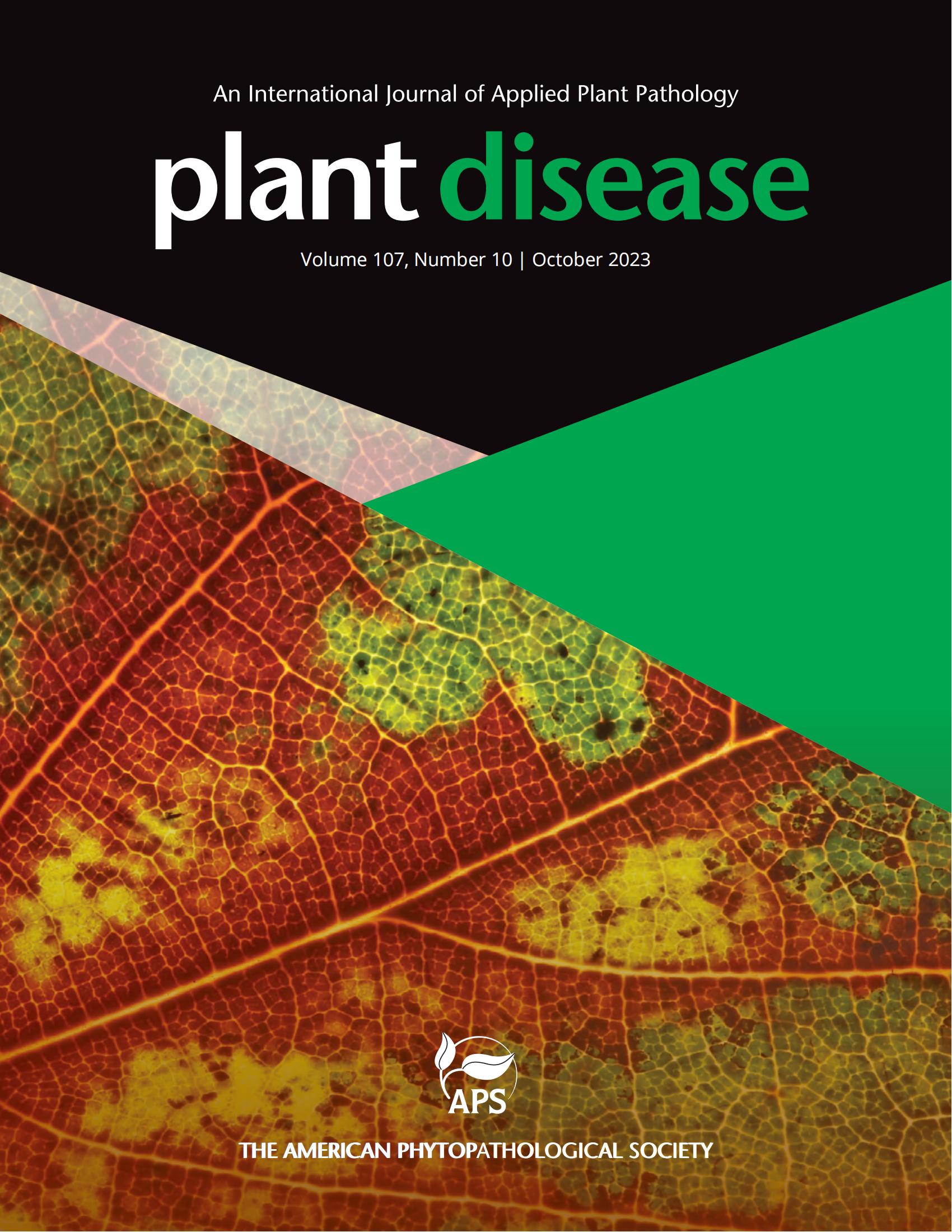中国首次报道黄精茎腐病的增殖镰刀菌。
摘要
黄精(Polygonatum cyrtonema Hua,天门冬科)是中国广泛分布的多年生草本植物(Chen et al. 2021)。根茎具有抗氧化、抗炎和免疫调节特性,传统上用于治疗头晕、糖尿病和哮喘(Lu et al. 2023;Pang et al. 2022)。2023年6 - 10月,在北京市药用植物发展研究所(40.04°N, 116.28°E)的5个试验田中,共种植了约3000株cyrtonema根茎腐病,发病率约为10%。大多数病例发生在低洼、涝渍地区。最初,受感染植株地上部无明显症状,但根茎上有褐色斑点。严重者表现为地上萎蔫和根茎褐腐病。从有症状的植株中分离出一株真菌(分离率73%),利用单个孢子在马铃薯-葡萄糖-琼脂(PDA)上培养纯菌落,25℃黑暗培养5 d。获得了11株形态相同的分离株。菌落上表面白色,有棉质菌丝,中心浅紫色。菌落的下表面中心呈淡褐色。C76和C78两株有代表性的分离株在康乃馨叶片琼脂培养基上培养。菌株的微分生孢子大小为4.9 ~ 12.1 × 1.5 ~ 4.5 μm (n = 50),呈无菌型、椭圆形、椭圆形或棒状。大分生孢子长、细、细,杆状或微弯曲,隔1 ~ 5个,尺寸为15.3 ~ 44.9 × 2.7 ~ 4.5 μm (n = 50)。根据形态将分离物分类为镰刀菌(Leslie and Summerell 2006)。为了确定物种身份,我们对两个分离株(即C76和C78)的翻译延伸因子(TEF-1α)和部分RNA聚合酶第二大亚基(RPB2)进行了测序,GenBank访问号:TEF-1α, PQ550044, PQ285402;分别为RBP2, PQ550045, PQ285403) (Crous et al . 2009),并将其与Fusarium- id和GenBank数据库中发现的其他镰刀菌进行比较。两个分离株与增殖镰刀菌的相似性分别为99.84% (TEF-1α, MT305203)和100% (RBP2, LT841252)。利用MEGA6将TEF-1α与RBP2结合构建系统发育树,两株分离株与增殖F.聚类。为验证其致病性,将设计为C76的增芽胞杆菌分离株的分生孢子悬浮液2 mL (1 × 106个/mL)滴在4个根状茎表面,不损伤根状茎。作为对照,在两个对照根茎上施用无菌水。所有治疗均重复3次。幼苗在25°C的潮湿土壤中生长。7 d后,接种根表现出与田间相似的症状,而对照根无症状。从患病的根中重新分离出相同的分离物,并根据形态特征进行鉴定,符合Koch的假设。基于形态学和分子生物学,分离物被鉴定为F. proliferatum,这是一种普遍存在的病原体(Li, et al. 2017),据报道会引起P. cyrtonema的叶斑病(Zhou, et al. 2021)。这是第一次报道增殖性真菌在胞体真菌上引起根茎腐病。本研究将有助于制定根腐病防治策略。Polygonatum cyrtonema Hua (Asparagaceae) is a perennial herb widely distributed in China (Chen et al. 2021). The rhizome has antioxidant, anti-inflammatory, and immunomodulatory properties and is traditionally used to treat dizziness, diabetes, and asthma (Lu et al. 2023; Pang et al. 2022). About 3000 P. cyrtonema plants were planted in five fields at the Institute of Medicinal Plant Development (40.04°N, 116.28°E), Beijing, China, where rhizome rot was observed from June to October 2023, with an incidence rate of about 10%. Most cases occurred in low-lying, waterlogged fields. Initially, infected plants had no obvious aboveground symptoms but had brown spots on their rhizomes. In severe cases, plants exhibited aboveground withering and brown rot in rhizomes. A fungus was isolated from symptomatic plants (isolation rate 73%), and single spores were used to grow pure colonies on potato-dextrose-agar (PDA) and incubated for 5 d at 25°C in the dark. Eleven isolates with the same morphology were obtained. The upper surface of the colonies was white, with cottony mycelium and a light purple center. The lower surface of the colonies was hazel in the center. Two representative isolates, C76 and C78, were cultivated on carnation leaf agar medium. Microconidia of the isolates were aseptate, oval, elliptic or clavate, and their dimensions were 4.9 to 12.1 × 1.5 to 4.5 μm (n = 50). Macroconidia were long, slender and thin, rod-shaped or slightly curved, with one to five septa, and their dimensions were 15.3 to 44.9 × 2.7 to 4.5 μm (n = 50). The isolates were classified as Fusarium based on morphology (Leslie and Summerell 2006). To determine the species identity, we sequenced the translation elongation factor (TEF-1α) and partial RNA polymerase second largest subunit (RPB2) of two isolates (i.e., C76 and C78, GenBank access numbers: TEF-1α, PQ550044, PQ285402; RBP2, PQ550045, PQ285403, respectively) (Crous et al 2009) and compared them to other Fusarium species found at Fusarium-ID and GenBank databases. Both isolates exhibited 99.84% (TEF-1α, MT305203) and 100% (RBP2, LT841252) similarity with Fusarium proliferatum. The phylogenetic tree was constructed by combining TEF-1α, and RBP2 using MEGA6, and the two isolates clustered with F. proliferatum. To demonstrate pathogenicity, 2 mL of conidial suspension (1 × 106 conidia/mL) of the isolate of F. proliferatum designed C76 were dropped on the surface of four rhizomes without wounding. For the control, sterile water was applied on two control rhizomes. All treatments were repeated three times. Seedlings were grown at 25°C in moist soil. After 7 d, inoculated roots exhibited similar symptoms to those in the field, while control roots showed no symptoms. The same isolate was reisolated from diseased roots and was identified based on morphological characteristics, fulfilling Koch's postulates. Based on morphology and molecular biology, the isolates were identified as F. proliferatum, a ubiquitous pathogen (Li, et al 2017) that was reported to cause leaf spot on P. cyrtonema (Zhou, et al. 2021). This is the first report of F. proliferatum causing rhizome rot on P. cyrtonema. This research will help develop strategies to manage rhizome rot incited by F. proliferatum.

 求助内容:
求助内容: 应助结果提醒方式:
应助结果提醒方式:


